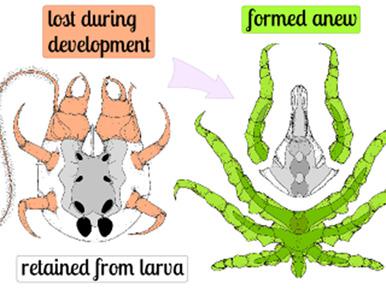当前位置:
X-MOL 学术
›
J. Morphol.
›
论文详情
Our official English website, www.x-mol.net, welcomes your
feedback! (Note: you will need to create a separate account there.)
Anatomical changes in postembryonic development of Pycnogonum litorale
Journal of Morphology ( IF 1.5 ) Pub Date : 2020-12-25 , DOI: 10.1002/jmor.21308 Nina Alexeeva 1 , Yuta Tamberg 2
Journal of Morphology ( IF 1.5 ) Pub Date : 2020-12-25 , DOI: 10.1002/jmor.21308 Nina Alexeeva 1 , Yuta Tamberg 2
Affiliation

|
Sea spiders (Pycnogonida) are a small group of arthropods, sister to other chelicerates. They have an unusual adult bauplan, oligosegmented larvae, and a protracted postembryonic development. Pycnogonum litorale (Strøm, 1762) is an uncommonly long-lived sea spider with a distinctive protonymphon and adult anatomy. Although it was described ~250 years ago, little is known about its internal organization and development. We examined the anamorphic and early epimorphic development of this species using histology, light microscopy, and SEM, and provide the first comprehensive anatomical study of its many instars. Postembryonic development of P. litorale includes transformations typical of pycnogonids: reorganization of the larval organs (digestive, nervous, secretory), formation of the abdomen, trunk segments (+ appendages), primary body cavity and reproductive system. Specific traits include the accelerated articulation of the walking legs, formation of the subesophageal and posterior synganglia, and the system of twin midgut diverticula. In addition, P. litorale simultaneously lose the spinning apparatus and all larval appendages. We found that developmental changes occur in synchrony with changes in ecology and food sources. The transition from the anamorphic to the epimorphic period in particular is marked by considerable anatomical and lifestyle shifts. HIGHLIGHTS: Postembryonic development of P. litorale includes numerous anamorphic and epimorphic stages. The instars acquire abdomen, trunk segments, body cavity, and gonads, while losing all larval appendages. Developmental changes are synchronized with changes in lifestyle and food sources.
中文翻译:

Pycnogonum litorale 胚胎后发育的解剖学变化
海蜘蛛(Pycnogonida)是一小群节肢动物,是其他螯肢的姐妹。它们有一个不寻常的成虫 bauplan、寡节段幼虫和长期的胚胎后发育。Pycnogonum litorale (Strøm, 1762) 是一种罕见的长寿海蜘蛛,具有独特的原虫和成体解剖结构。尽管它在大约 250 年前就被描述过,但对其内部组织和发展知之甚少。我们使用组织学、光学显微镜和扫描电镜检查了该物种的变形和早期外胚发育,并对其许多龄期进行了首次全面的解剖研究。P. litorale 的胚胎后发育包括 pycnogonids 的典型转化:幼虫器官(消化、神经、分泌)的重组,腹部、躯干节段(+ 附属物)的形成,初级体腔和生殖系统。具体特征包括步行腿的加速关节、食管下和后神经节的形成以及双中肠憩室系统。此外,P. litorale 同时失去旋转装置和所有幼虫附属物。我们发现发育变化与生态和食物来源的变化同步发生。特别是从变形期到变形期的过渡以相当大的解剖学和生活方式转变为标志。亮点:P. litorale 的胚胎后发育包括许多变形和外胚阶段。幼虫获得腹部、躯干节段、体腔和性腺,同时失去所有幼虫附属物。发育变化与生活方式和食物来源的变化同步。具体特征包括步行腿的加速关节、食管下和后神经节的形成以及双中肠憩室系统。此外,P. litorale 同时失去旋转装置和所有幼虫附属物。我们发现发育变化与生态和食物来源的变化同步发生。特别是从变形期到变形期的过渡以相当大的解剖学和生活方式转变为标志。亮点:P. litorale 的胚胎后发育包括许多变形和外胚阶段。幼虫获得腹部、躯干节段、体腔和性腺,同时失去所有幼虫附属物。发育变化与生活方式和食物来源的变化同步。具体特征包括步行腿的加速关节、食管下和后神经节的形成以及双中肠憩室系统。此外,P. litorale 同时失去旋转装置和所有幼虫附属物。我们发现发育变化与生态和食物来源的变化同步发生。特别是从变形期到变形期的过渡以相当大的解剖学和生活方式转变为标志。亮点:P. litorale 的胚胎后发育包括许多变形和外胚阶段。幼虫获得腹部、躯干节段、体腔和性腺,同时失去所有幼虫附属物。发育变化与生活方式和食物来源的变化同步。
更新日期:2020-12-25
中文翻译:

Pycnogonum litorale 胚胎后发育的解剖学变化
海蜘蛛(Pycnogonida)是一小群节肢动物,是其他螯肢的姐妹。它们有一个不寻常的成虫 bauplan、寡节段幼虫和长期的胚胎后发育。Pycnogonum litorale (Strøm, 1762) 是一种罕见的长寿海蜘蛛,具有独特的原虫和成体解剖结构。尽管它在大约 250 年前就被描述过,但对其内部组织和发展知之甚少。我们使用组织学、光学显微镜和扫描电镜检查了该物种的变形和早期外胚发育,并对其许多龄期进行了首次全面的解剖研究。P. litorale 的胚胎后发育包括 pycnogonids 的典型转化:幼虫器官(消化、神经、分泌)的重组,腹部、躯干节段(+ 附属物)的形成,初级体腔和生殖系统。具体特征包括步行腿的加速关节、食管下和后神经节的形成以及双中肠憩室系统。此外,P. litorale 同时失去旋转装置和所有幼虫附属物。我们发现发育变化与生态和食物来源的变化同步发生。特别是从变形期到变形期的过渡以相当大的解剖学和生活方式转变为标志。亮点:P. litorale 的胚胎后发育包括许多变形和外胚阶段。幼虫获得腹部、躯干节段、体腔和性腺,同时失去所有幼虫附属物。发育变化与生活方式和食物来源的变化同步。具体特征包括步行腿的加速关节、食管下和后神经节的形成以及双中肠憩室系统。此外,P. litorale 同时失去旋转装置和所有幼虫附属物。我们发现发育变化与生态和食物来源的变化同步发生。特别是从变形期到变形期的过渡以相当大的解剖学和生活方式转变为标志。亮点:P. litorale 的胚胎后发育包括许多变形和外胚阶段。幼虫获得腹部、躯干节段、体腔和性腺,同时失去所有幼虫附属物。发育变化与生活方式和食物来源的变化同步。具体特征包括步行腿的加速关节、食管下和后神经节的形成以及双中肠憩室系统。此外,P. litorale 同时失去旋转装置和所有幼虫附属物。我们发现发育变化与生态和食物来源的变化同步发生。特别是从变形期到变形期的过渡以相当大的解剖学和生活方式转变为标志。亮点:P. litorale 的胚胎后发育包括许多变形和外胚阶段。幼虫获得腹部、躯干节段、体腔和性腺,同时失去所有幼虫附属物。发育变化与生活方式和食物来源的变化同步。











































 京公网安备 11010802027423号
京公网安备 11010802027423号